 W
WThe action of 10 August 1780 was a minor naval engagement that took place off Brest during the American Revolutionary War between a Royal Navy frigate and a French Navy frigate. This was the first engagement thought to involve the use of the carronade.
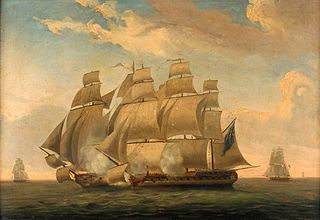 W
WThe action of 2 January 1783 was a minor naval battle that took place in the Caribbean Sea during the last stages of the American War of Independence. Severe fighting between a Royal Navy frigate HMS Magicienne and a French frigate Sibylle went on for nearly two hours, but in that time both frigates were reduced to wrecks.
 W
WThe action of 10 September 1782 was a minor engagement between five merchant vessels — four East Indiamen of the British East India Company and a country-ship — on the one side, and a French frigate on the other. The action resulted in only a few casualties and was inconclusive. What was noteworthy was that the Indiamen sought out the French man-of-war and attacked it; it would have been more usual for the merchantmen to have avoided combat as they had little to gain from a battle.
 W
WThe action of 12 December 1782 was a naval engagement fought off the coast of Spain near Ferrol, in which the British 40-gun fifth rate HMS Mediator successfully attacked a convoy of five armed ships. Mediator succeeded in capturing one American privateer, the Alexander, and then captured the French ex-ship of the line La Ménagère. The convoy was part of Pierre Beaumarchais's supply chain to the American colonists.
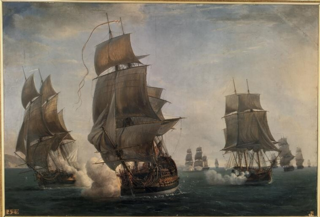 W
WThe action of 17 August 1779 was a naval battle between a French and a British squadron in the English Channel on 17 August 1779.
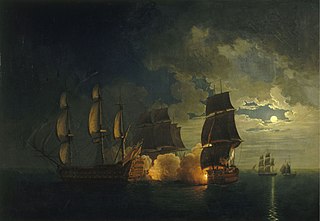 W
WThe action of 18 October 1782 was a minor naval engagement of the American Revolutionary War, in which the French 74-gun ship of the line Scipion, accompanied by a frigate, was chased by two Royal Navy ships of the line, HMS London and Torbay. Outmanoeuvring her larger opponents, Scipion obtained a favourable position that allowed her to rake HMS London, causing severe damage and escaping.
 W
WThe action of 21 July 1781 was a naval skirmish off the harbour of Spanish River, Cape Breton, Nova Scotia, during the War of American Independence. Two light frigates of the French Navy, captained by La Pérouse and Latouche Tréville, engaged a convoy of 18 British ships and their Royal Navy escorts. The French captured two of the British escorts while the remainder of the British convoy escaped.
 W
WThe action of 24 February 1780 was a minor naval battle that took place off the island of Madeira during the American Revolutionary war. A French convoy was intercepted and pursued by a British Royal Navy squadron ending with the French 64 gun ship Protée being captured along with three transports.
 W
WThe action of 29 July 1782 was a minor naval engagement that took place towards the end of the American War of Independence. The British Royal Navy frigate HMS Santa Margarita captured the 36-gun French frigate Amazone off Cape Henry, but the next day the squadron under Louis-Philippe de Vaudreuil intervened and recaptured the frigate.
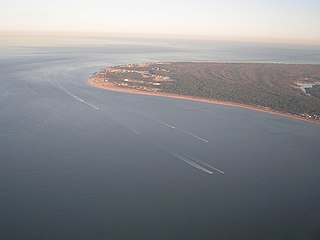 W
WThe Battle of Cape Henry was a naval battle in the American War of Independence which took place near the mouth of Chesapeake Bay on 16 March 1781 between a British squadron led by Vice Admiral Mariot Arbuthnot and a French fleet under Admiral Charles René Dominique Sochet, Chevalier Destouches. Destouches, based in Newport, Rhode Island, had sailed for the Chesapeake as part of a joint operation with the Continental Army to oppose the British army of Brigadier General Benedict Arnold that was active in Virginia.
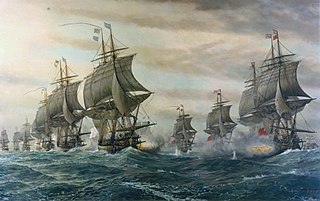 W
WThe Battle of the Chesapeake, also known as the Battle of the Virginia Capes or simply the Battle of the Capes, was a crucial naval battle in the American Revolutionary War that took place near the mouth of the Chesapeake Bay on 5 September 1781. The combatants were a British fleet led by Rear Admiral Sir Thomas Graves and a French fleet led by Rear Admiral François Joseph Paul, the Comte de Grasse. The battle was strategically decisive, in that it prevented the Royal Navy from reinforcing or evacuating the besieged forces of Lieutenant General Lord Cornwallis at Yorktown, Virginia. The French were able to achieve control of the sea lanes against the British and provided the Franco-American army with siege artillery and French reinforcements. These proved decisive in the Siege of Yorktown, effectively securing independence for the Thirteen Colonies.
 W
WThe Battle of Fort Royal was a naval battle fought off Fort Royal, Martinique in the West Indies during the Anglo-French War on 29 April 1781, between fleets of the British Royal Navy and the French Navy. After an engagement lasting four hours, the British squadron under Admiral Samuel Hood broke off and retreated. Admiral de Grasse offered a desultory chase before seeing the French convoys safe to port.
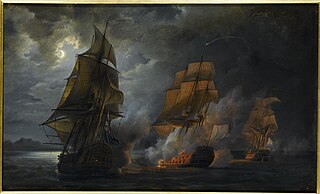 W
WThe action of 20 October 1778 was an inconclusive engagement between the French ship-of-the-line Triton and British ship-of-the-line Jupiter with a frigate Medea that took place off Cape Finisterre in the Bay of Biscay. Darkness separated the combatants before any decisive result was obtained.
 W
WThe Battle of the Saintes, also known as the Battle of Dominica, was an important naval battle in the Caribbean between the British and the French that took place 9–12 April 1782. The British victory was considered their greatest over the French during the American Revolutionary War.
 W
WThe Second Battle of Ushant was a naval battle fought between French and British squadrons near Ushant, an island off the coast of Brittany, on 12 December 1781, as part of the American Revolutionary War.
 W
WThe Third Battle of Ushant or the action of 20–21 April 1782 was a naval battle fought during the American Revolutionary War, between a French naval fleet of three ships of the line protecting a convoy and two British Royal naval ships of the line off Ushant, a French island at the mouth of the English Channel off the northwesternmost point of France. This was the third battle that occurred in this region during the course of the war.